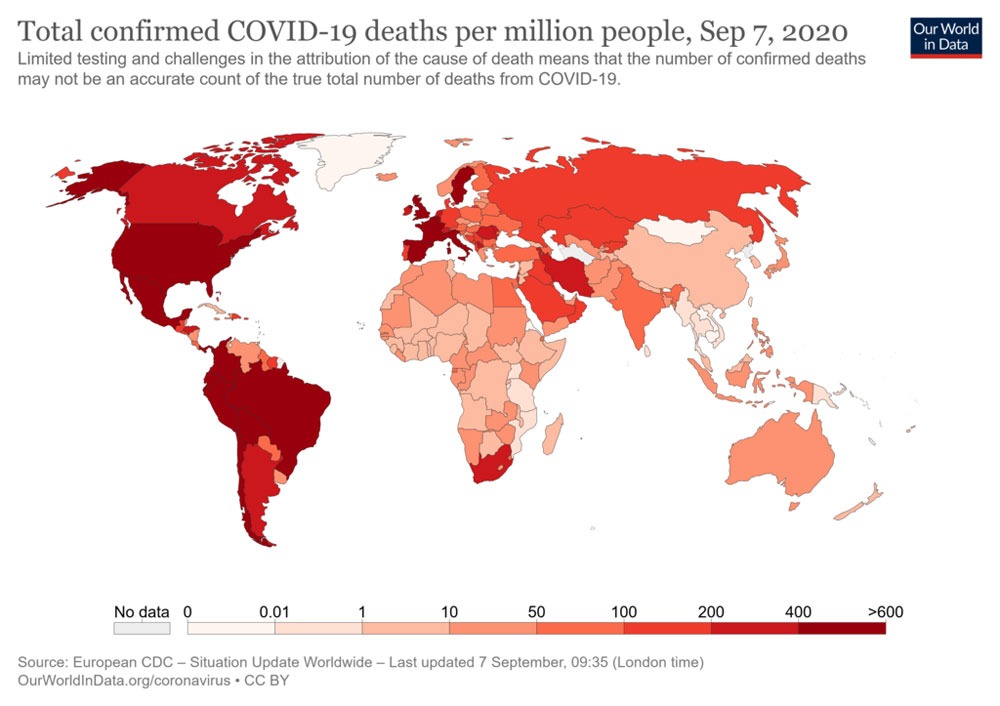
September 28, 2020; NPR
September 2020 will forever mark 1 million worldwide deaths from the novel coronavirus called COVID-19, first reported on December 31, 2019, in Wuhan, Gansu Province, China. By January 28, 2020, the Chinese government had declared a Wuhan lockdown and required people to wear face masks in public places, under recommendations by the Gansu Provincial Centre for Disease Control and Prevention. At that point, the virus had already been quickly spreading in Italy, Germany, Japan, South Korea, Thailand, Taiwan, and the United States. By January 30, the World Health Organization (WHO) had declared a “Public Health Emergency of International Concern” and, with a set of recommendations, stated:
WHO should continue to provide all necessary technical and operational support to respond to this outbreak, including with its extensive networks of partners and collaborating institutions, to implement a comprehensive risk communication strategy, and to allow for the advancement of research and scientific developments in relation to this novel coronavirus.
[…]
As this is a new coronavirus, and it has been previously shown that similar coronaviruses required substantial efforts to enable regular information sharing and research, the global community should continue to demonstrate solidarity and cooperation.
The US began screening for the new virus at airports in New York, San Francisco, and Los Angeles and confirmed the first case on January 21, when a man who had traveled back from Wuhan to Washington state was diagnosed with coronavirus. The Trump administration declared a national emergency on March 13, 2020, but seven days later as many as 15,000 people in New York City had already tested positive for COVID-19 and Gov. Andrew Cuomo ordered all nonessential businesses closed statewide.
During the first couple of months of 2020, President Trump was still congratulating China, President Xi Jinping, the “World Health,” and the CDC on having everything “very well under control.” But when the stock market crashed on February 20, the tune began to change very quickly, and disinformation about the virus became the White House’s main strategy. A big tell was how the word “Corona” was crossed out and replaced with “Chinese” on the president’s notes during a press briefing in mid-March, launching a xenophobic campaign to pin the “Chinese virus” problem on everyone except the US response. Secretary of State Mike Pompeo ignored Beijing’s pleas to stop referring to it as the “Wuhan virus,” and so began a diplomatic clash between the two nations.
Sign up for our free newsletters
Subscribe to NPQ's newsletters to have our top stories delivered directly to your inbox.
By signing up, you agree to our privacy policy and terms of use, and to receive messages from NPQ and our partners.
By mid-April, the Trump administration began to actively undermine the World Health Organization by threatening to freeze its funding and officially announced it would withdraw from the WHO (and therefore, the scientific world’s response to COVID-19) on May 29. ProPublica spoke to several officials who warned that such stance would have “profound and severe repercussions,” including impeding access to a vaccine developed through international cooperation. By then, the US had already surpassed the rest of the world in coronavirus cases (1,712,637) and deaths (95,705).
Meanwhile, the rest of the democratic world was on a diametrically opposed path. Countries like Germany and South Korea, as well as cities like Hong Kong and Singapore, began implementing WHO’s recommendations to test, trace, and quarantine people suspected with coronavirus since February. African nations like Senegal, with a population of 16 million, decided to take no chances and quickly took measures, registering only 362 deaths so far, according to the Washington Post. In Rwanda, COVID-19 testing and treatment is free and has recorded only 26 deaths.
A coordinated international effort of 64 high-income nations are funding the development, manufacturing, and distribution of COVID-19 vaccines through the COVAX Facility Initiative and the WHO. In doing so, they want to guarantee quicker results while making sure access and affordability for lower-income nations. A total of 156 countries—except the US, China, and Russia—are expected to participate and purchase 2 billion doses of the vaccine by the end of 2021.
“Vaccine nationalism will only perpetuate the disease and prolong the global recovery,” WHO Director-General Tedros Adhanom Ghebreyesus told STAT health news.
Only Mexico, India, and Brazil, countries where authoritative governments have promoted denialism instead of active efforts to curve the coronavirus, have comparable number of COVID-19 cases to the US—yet all three joined the COVAX initiative by its September 18 deadline.
Members of the European Union like France and Germany, while backing COVAX, are also supporting the private manufacturing of COVID-19 vaccines, expected to be available by the end of 2020 through companies such as Pfizer and BioNTech. The Trump administration has instead unveiled the “Operation Warp Speed” vaccine initiative, which deceptively promises a vaccine to be delivered two days before the election, while also making several billionaire deals with multiple companies, including Pfizer, at an estimated $19.50 per shot.
Unfortunately, going it alone will deny the US the opportunity to distribute a vaccine equitably and effectively. It’s also diminished public trust in such a vaccine’s effectiveness. A survey in August showed that one in three Americans said they would not get a COVID-19 vaccine. “This is gonna go away without a vaccine,” Donald Trump said in early May. “It’s gonna go away, and we’re not gonna see it again, hopefully, after a period of time.”—Sofia Jarrin-Thomas













